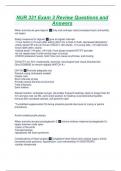NUR 331 Exam 3 Review Questions and
Answers
When and why we give digoxin ✅Only oral ionitropic med (increases heart contractility,
not faster)
Safety measures for digoxin ✅-give at regular intervals
-1 hour before or 2 hours after eating (dont mix w food or fluid> decreased absorption)
-check apical HR one full minute (HOLD if <90 infants, 110 young kids, <70 older kids)
-brsuh teeth after> stains
-missed dose? <4h give, >4h hold, if two doses missed NOTIFY provider
-do not repeat dose if child vomits>sign of toxicity
-CHECK potassium levels, hold if low (can cause arrythmias, and toxicity)
TOXICITY s/s: N/V, bradycardia, anorexia, neurological and visual disturbances
Give DIGIBIND to remove digitalis WATCH K+
CHF NI ✅Promote adequate rest
Prevent crying (anticipate needs0
Cluster care
Short intervals of play
Provide neutral thermal environment
Treat infections
Semi fowlers
Altered nutrition: anticipate hunger, q3 smaller frequent feedings, feed no longer than 30
min and give rest via NG, semi-erect position for feeding, burp before/during/after,
formula with increased calories, soft preemie niple
**humidified supplemental O2 during stressful periods like bouts of crying or painful
procedures
Avoid crowded public places,
When and why we give prostaglandin E ✅mimics mothers maternal prostaglandin E>
keeps foremen ovale open
Coarc of the aorta
Tricuspid atresia
Hypoplastic left heart syndrome
Complications of heart surgery ✅Congestive heart failure (low cardiac output, shock,
narrowed pulse pressure, hypotension, cool extremeties) IV IONOTROPIC
-cardiac tamponade
,-atelectasis, pneumothorax, pulmunarary edema, pleural effusions
-sudden stop of chest tube
-cerebral edema, hemmorrhage
-low urine output=decreased perfusion to kidneys
Discharge: wounds care, infection s/s, dont put strain on incison (dont pick up by the
arms ofr 2 wks), bacterial encocarditis prophylaxis, self limit activities (avoid situations
where they could fall)
Aortic stenosis ✅What is it: narrowed area of the aortic valve, inability for LV to pump
blood (decreased CO), also interferes with coronary circulation> pulmonary vascular
congestion
hypertrophy of the left ventricle (INCREASED RISK OF HEART ATTACK), increased
risk of endocarditis
S/s: faint pulse, hypotension, tachycardia (compensatory), poor feeding (decreased
CO), exercise intolerance, chest pain, dizziness when standing for long periods
How is it treated: surgery, rarely results in normal valve
NI
*limit activity prior to surgery (not bed rest)
Tetralogy of Fallot ✅What is it: decreased pulmonary blood flow
VSD, overriding aorta, pulmonic stenosis, right ventricular hypertrophy
Right to left shunt> cyanosis *Tet spell *(agitation triggers this, will squat to reroute
blood)
S/s: murmur with a thrill, polycythemia, hypoxic spells(high stress) (squatting position),
metabolic acidosis, poor growth, clubbing, exercise introlerance
How is it treated: multi step surgery
NI:
Guidelines for hypercyantoic spells ✅Occur during high stress times for cyanotic heart
defects
1. Be calm
2. Knee-chest position * call for back up
3. 100% O2 by face mask
4. Give morphine (helps more blood leave the RV into pulmonic artery, relaxes muslce)
5. IV fluid replacement and volume expansion if needed
6. Repeat morphine if needed
**in this order, do one and wait
, Cyanotic heart defects ✅RIGHT TO LEFT SHUNTING
Decreased pulmonary blood flow (decreased oxygenation)
Lots of mixing of the blood
> HYPOXIA
Cyanosis, polycythemia, digital clubbing, altered ABG's
NI: provde really good skin care (poor blood flow, edema), supplemental O2, monitor
and prevent dehydration, developmentally appropriate prepation for tests/procedures,
prevention of respirotory infections
ASD ✅What is it: acyanotic, increased pulmonary blood flow, LEFT ATRIA TO RIGHT
ATRIA
S/s: asymptomatic, heart murmur, CHF (not likely), increased risk for dysrhthmias with
pulmonary obstructive disease/emboli later in life
How is it treated: open heart surgery patch, or during cardiac cath, most close
spontaneously
NI
VSD ✅What is it: increased pulmonary blood flow, opening between ventricles LEFT
TO RIGHT ventricle most common=not enough oxygenated blood leaving the LV more
blood to lungs
S/s: pulmonary congestion, CHF, cyanosis, characteristic murmur, right ventricular
hypertropy, FTT, fatigue, recurrent respiratory infections
**risk for enodcarditis, pulmonary vascular obstructive disease
How is it treated: pulmonary arter banding (decrease pulmonary blood flow), may close
spontaneously by age 3, surgical correction
NI
PDA ✅What is it: increased pulmonary blood flow, ductus arteriosus failed to close
blood is shunted from the aorta to the pulmonary artery (more blood to lungs, less to
body)
S/s: machine like murmur, asymptomatic, CHF
How is it treated: prostaglandin E INHIBITOR (indomethacin, ibuprofen) will help close.
TWO DOSE max > cath lab coil or VATS to clip closed
NI
coarctation of the aorta ✅Obstructive decreased blood flow to body: narrowing of the
aortic arch (more blood flow to head and neck, decreased blood flow to lower
extremities) can occur in several spots
-LEFT TO RIGHT shunting, increased pulmonary bllood flow leading to CHF
S/s: HA, dizzyness, nose bleeds, higher BP in upper extremites, stroke, aortic
aneurysm, rupture aorta, weak/absent femoral pulses, cool/mottled legs, leg pain, weak
legs, delayed wound healing in the legs
**BP in both upper extremites and one lower** to compare***




